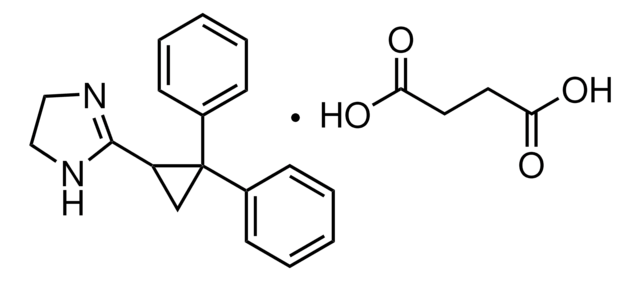5.31552
Argonaute-2 Inhibitor, BCI-137
Synonim(y):
Argonaute-2 Inhibitor, BCI-137, 2-(2,3-Dioxo-1,2,3,4-tetrahydroquinoxaline-6-sulfonamido) propanoic acid, N-((2,3-Dihydroxy-6-quinoxalinyl)sulfonyl)alanine, Ago2 Inhibitor, BCI137
About This Item
Polecane produkty
Próba
≥97% (HPLC)
Poziom jakości
Postać
solid
siła działania
126 μM Kd
producent / nazwa handlowa
Calbiochem®
warunki przechowywania
OK to freeze
protect from light
kolor
gray-white
rozpuszczalność
DMSO: 100 mg/mL
temp. przechowywania
2-8°C
ciąg SMILES
CC(C(=O)O)NS(=O)(=O)C1=CC2=C(C=C1)NC(=O)C(=O)N2
Opis ogólny
Please note that the molecular weight for this compound is batch-specific due to variable water content.
Działania biochem./fizjol.
Argonaute-2
Opakowanie
Ostrzeżenie
Rekonstytucja
Inne uwagi
Informacje prawne
Kod klasy składowania
11 - Combustible Solids
Klasa zagrożenia wodnego (WGK)
WGK 3
Temperatura zapłonu (°F)
Not applicable
Temperatura zapłonu (°C)
Not applicable
Certyfikaty analizy (CoA)
Poszukaj Certyfikaty analizy (CoA), wpisując numer partii/serii produktów. Numery serii i partii można znaleźć na etykiecie produktu po słowach „seria” lub „partia”.
Masz już ten produkt?
Dokumenty związane z niedawno zakupionymi produktami zostały zamieszczone w Bibliotece dokumentów.
Nasz zespół naukowców ma doświadczenie we wszystkich obszarach badań, w tym w naukach przyrodniczych, materiałoznawstwie, syntezie chemicznej, chromatografii, analityce i wielu innych dziedzinach.
Skontaktuj się z zespołem ds. pomocy technicznej







